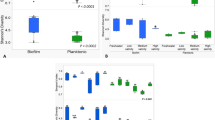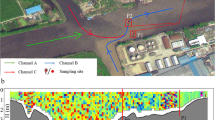Abstract
Despite our dependency on treatment facilities to condition wastewater for eventual release to the environment, our knowledge regarding the effects of treated water on the local watershed is extremely limited. Responses of lotic systems to the treated wastewater effluent have been traditionally investigated by examining the benthic macroinvertebrate assemblages and community structure; however, these studies do not address the microbial diversity of the water systems. In the present study, planktonic and benthic bacterial community structure were examined at 14 sites (from 60 m upstream to 12,100 m downstream) and at two time points along an aquatic system receiving treated effluent from the Charleston Wastewater Treatment Plant (Charleston, IL). Total bacterial DNA was isolated and 16S rRNA sequences were analyzed using a metagenomics platform. The community structure in planktonic bacterial communities was significantly correlated with dissolved oxygen concentration. Benthic bacterial communities were not correlated with water quality but did have a significant geographic structuring. A local restructuring effect was observed in both planktonic and benthic communities near the treated wastewater effluent, which was characterized by an increase in abundance of sphingobacteria. Sites further downstream from the wastewater facility appeared to be less influenced by the effluent. Overall, the present study demonstrated the utility of targeted high-throughput sequencing as a tool to assess the effects of treated wastewater effluent on a receiving water system, and highlighted the potential for this technology to be used for routine monitoring by wastewater facilities.



Similar content being viewed by others
References
Al-Awadhi, H., Dashti, N., Khanafer, M., Al-Mailem, D., Ali, N., & Radwan, S. (2013). Bias problems in culture-independent analysis of environmental bacterial communities: a representative study on hydrocarbonoclastic bacteria. Springerplus, 2, 369–380.
Amann, R., Ludwig, W., & Schleifer, K. H. (1995). Phylogenetic identification and in situ detection of individual microbial cells without cultivation. Microbiological Reviews, 59, 143–169.
Bae, Y., Kil, H., & Bae, K. (2005). Benthic macroinvertebrates for uses in stream biomonitoring and restoration. KSCE Journal of Civil Engineering, 9, 55–63.
Bartram, A., Lynch, M., Stearns, J., Moreno-Hagelsieb, G., & Neufeld, J. (2011). Generation of multimillion-sequence 16S rRNA gene libraries from complex microbial communities by assembling paired-end Illumina reads. Applied and Environmental Microbiology, 77, 3846–3852.
Biggs, B. (2000). Eutrophication of streams and rivers: dissolved nutrient-chlorophyll relationships for benthic algae. Journal North American Benthol Social, 19, 17–31.
Brooks, B., Riley, T., & Taylor, R. (2006). Water quality of effluent-dominated ecosytems: ecotoxicological, hydrological, and management considerations. Hydrobiologia, 556, 365–379.
Burnham, K. P., & Anderson, D. R. (2002). Model selection and multimodal inference: a practical information-theoretic approach (2nd ed.). New York, NY: Springer Science + Business Media.
Cairns Jr., J., & Pratt, J. R. (1993). A history of biological monitoring using benthic macroinvertebrates. In R. DM & V. H. Resh (Eds.), Freshwater biomonitoring and benthic macroinvertebrates. New York, NY: Chapman & Hall.
Cao, Y., Bark, A., & Williams, P. (1996). Measuring the responses of macroinvertebrate communities to water pollution: a comparison of multivariate approaches, biotic and diversity indices. Hydrobiologia, 341, 1–19.
Carpenter, S., Caraco, N., Correll, D., Howarth, R., Sharpley, A., & Smith, V. (1998). Nonpoint pollution of surface waters with phosphorus and nitrogen. Ecological Applications, 8, 559–568.
Clarridge, J. (2004). Impact of 16S rRNA gene sequence analysis for identification of bacteria on clincical microbiology and infection diseases. Clinical Microbiology Reviews, 17, 840–862.
Daims, H., Taylor, M., & Wagner, M. (2006). Wastewater treatment: a model system for microbial ecology. Trends in Biotechnology, 24, 483–489.
Desai, C., Pathlak, H., & Madamwar, D. (2010). Advances in molecular and “-omic” technologies to gauge microbial communities and bioremediation at xenobiotic/anthropogen contaminated sites. Bioresource Technology, 101, 1558–1569.
Drury, B., Rosi-Marshall, E., & Kelly, J. (2013). Wastewater treatment effluent reduces abundance and diversity of benthic bacterial communities in urban and suburban rivers. Applied and Environmental Microbiology, 79, 1897–1905.
Gaufin, A., & Tarzwell, C. (1956). Aquatic macro-invertebrate communities as indicators of organic pollution in Lytle Creek. Sewage and Industrial Wastes, 28, 906–924.
Gilbride, K., Lee, D., & Beaudette, L. (2006). Molecular techniques in wastewater: understanding microbial communities, detecting pathogens, and real-time process control. Journal Microbiol Methods, 66, 1–20.
Goldenfeld, N. (2014). Looking in the right direction: Carl Woese and evolutionary biology. RNA Biology, 11, 248–253.
Grimm, N., Faeth, S., Golubiewski, N., Redman, C., Wu, J., Bai, X., & Briggs, J. (2008). Global change and the ecology of cities. Science, 319, 756–760.
Gucker, B., Brauns, M., & Pusch, M. (2006). Effects of wastewater treatment plants discharge on ecosystem structure and function of lowland streams. Journal North American Benthol Society, 25, 313–329.
Hugenholtz, P., Goebel, B., & Pace, N. (1998). Impact of culture-independent studies on emerging phylogenetic view of bacterial diversity. Journal of Bacteriology, 180, 4756–4774.
Kämpfer, P. T. (2010). Order Sphingobacteriales. In N. R. Krieg, W. Ludwig, W. Whitman, B. P. Hedlund, B. J. Paster, J. T. Staley, N. Ward, D. Brown, & A. Parte (Eds.), Bergey’s manual of systematic bacteriology (Vol. 4, 2nd ed.). New York, NY: Springer.
Koonin, E. (2014). Carl Woese’s vision of cellular evolution and the domains of life. RNA Biology, 11, 197–204.
Kozich, J., Westcott, S., Baxter, N., Highlander, S., & Schloss, P. (2013). Development of a dual-index sequencing strategy and curation pipeline for analyzing amplicon sequence data on the MiSeq Illumina sequencing platform. Applied and Environmental Microbiology, 81, 5112–5120.
Lambiase, A. (2014). The family Sphingobacteriaceae. In E. Rosenberg, E. F. DeLong, S. Lory, E. Stackebrandt, & F. Thompson (Eds.), The prokaryotes. Berlin, Heidelberg: Springer.
Legendre, P., & Anderson, M. J. (1999). Distance-based redundancy analysis: testing multispecies responses in multifactorial ecological experiments. Ecological Monographs, 69, 1–24.
Legendre, P., & Legendre, L. (2012). Numerical ecology (3rd ed.). Amsterdam, NL: Elsevier.
McLellan, S., Huse, S., Mueller-Spitz, S., Andreishcheva, E., & Sogin, M. (2010). Diversity and population structure of sewage-derived microorganisms in wastewater treatment plant influent. Environmental Microbiology, 12, 378–392.
Nold, S., & Zwart, G. (1998). Patterns and governing forces in aquatic microbial communities. Aquatic Ecology, 32, 17–35.
Qasim, S. R. (1999). Wastewater treatment plants: planning, design, and operation (2nd ed.). Boca Raton, FL: CRC Press.
Quast, C., Pruesse, E., Yilmaz, P., Gerken, J., Schweer, T., Yarza, P., Peplies, J., & Glöckner, F. O. (2013). The SILVA ribosomal RNA gene database project: improved data processing and web-based tools. Nuclear Acids Research, 41, D590–D596.
Rajendhran, J., & Gunasekaran, P. (2011). Microbial phylogeny and diversity: small subunit ribosomal RNA sequence analysis and beyond. Microbiological Research, 166, 99–110.
Sanapareddy, N., Hamp, T., Gonzalez, L., Helene, H., Fodor, A., & Clinton, S. (2009). Molecular diversity of a North Carolina wastewater treatment plant as revealed by pyrosequencing. Applied and Environmental Microbiology, 75, 1688–1696.
Schloss, P., Westcott, S., Ryabin, T., Hall, J., Hartmann, M., Hollister, E., Lesnewski, R., Oakley, B., Parks, D., Robinson, C., Sahl, J., Stres, B., Thallinger, G., Van Horn, D., & Weber, C. (2009). Introducing mothur: open-source, platform-independent, community-supported software for describing and comparing microbial communities. Applied and Environmental Microbiology, 75, 7537–7541.
Schluter, A., Krause, L., Szczepanowski, R., Goesmann, A., & Puhler, A. (2008). Genetic diversity and composition of a plasmid metagenome from a wastewater treatment plant. Journal of Biotechnology, 136, 65–76.
Smith, B., & Wilson, J. B. (1996). A consumer’s guide to evenness indices. Oikos, 76, 70–82.
Szczepanowski, R., Bekel, T., Goesmann, A., Krause, L., Kromeke, H., Kaiser, O., Eichler, W., Puhler, A., & Schluter, A. (2008). Insight into the plasmid metagenome of wastewater treatment plant bacteria showing reduced susceptibility to antimicrobial drugs analysed by the 454-pyrosequencing technology. Journal of Biotechnology, 136, 54–64.
Szczepanowski, R., Linke, B., Krahn, I., Garteman, K., Gutzkow, T., Eichler, W., Puhler, A., & Schluter, A. (2009). Detection of 140 clinically relevant antibiotic-resistance genes in the plasmid metagenome of wastewater treatment plant bacteria showing reduced susceptibility to selected antibiotics. Microbiology, 155, 2306–2319.
U.S. Environmental Protection Agency. 2010. Treating contaminants of emerging concern. EPA-820-R-10-002.
Wallace, J., & Webster, J. (1996). The role of macroinvertebrates in stream ecosystem function. Annual Review of Entomology, 41, 115–139.
Wynes, D., & Wissing, T. (1981). Effects of water quality on fish and macroinvertebrate communities. The Ohio Journal of Science, 81, 259–267.
Ye, Y. F., Min, H., & Du, Y. F. (2004). Characterization of a strain of Sphingobacterium sp. and its degradation to herbicide mefenacet. Journal of Environmental Sciences, 16, 343–347.
Acknowledgments
This work was supported by a Council on Faculty Research grant by Eastern Illinois University to Drs. Novak and Canam and a Graduate Assistantship provided to the Department of Biological Sciences at Eastern Illinois University by the City of Charleston, IL, through the Charleston Wastewater Treatment Plant
Author information
Authors and Affiliations
Corresponding author
Rights and permissions
About this article
Cite this article
Hladilek, M.D., Gaines, K.F., Novak, J.M. et al. Microbial community structure of a freshwater system receiving wastewater effluent. Environ Monit Assess 188, 626 (2016). https://doi.org/10.1007/s10661-016-5630-7
Received:
Accepted:
Published:
DOI: https://doi.org/10.1007/s10661-016-5630-7




